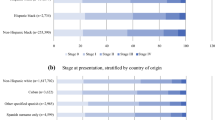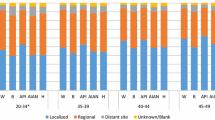Abstract
Purpose
Describe the clinical and epidemiological data from young women with breast cancer and determine the association between ethnicity, insurance status, family income, and breast cancer stage at the diagnosis in this population.
Methods
Women under the age of 40 diagnosed with invasive breast cancer from 2010 to 2014 and identified in the Surveillance, Epidemiology, and End Results (SEER) 18 registries database were included. Binary logistic regression was applied in order to estimate the odds ratios (ORs) for factors that were potentially predictive for receiving a breast cancer diagnosis at stage I.
Results
Of 14,379 young women with invasive breast cancer, 70.9% of the patients were white, 15.9% black, and 13.2% classified as other ethnicity (American Indian, Asian, Pacific Islander). The initial clinical stage at diagnosis was stage I in 28.2%, II in 45.2%, III in 19.0%, and IV in 7.6%. The chi-square test showed a significant association between clinical stage at diagnosis and family income (p < 0.0001), insurance status (p < 0.0001), and ethnicity (p < 0.0001). The ORs for being diagnosed at stage I, regarding different factors, revealed that women with family income higher than US$ 85,000 were more likely to be diagnosed with stage I (OR [95%CI], 1.306 [1.173–1.454]; p value < 0.0001) when compared with patients with family income of less than US$ 60,000. Black women were less likely to be diagnosed with stage I (OR [95%CI], 0.676 [0.605–0.755]; p value < 0.0001), when compared with white women. Uninsured women were less likely to be diagnosed with stage I (OR [95%CI], 0.586 [0.529–0.648]; p value < 0.0001) when compared with women with insurance coverage.
Conclusion
Among young US women diagnosed with invasive breast cancer, most of them presented early stage disease. Women with black ethnicity, low income, and uninsured are at risk for late-stage presentation. Improvements in strategies to allow earlier breast cancer diagnosis in these at risk population are urged.



Similar content being viewed by others
References
American Cancer Society. Breast cancer facts & figures 2017–2018.
International Agency for Research on Cancer. GLOBOCAN 2012: Estimated cancer incidence, Mortality and prevalence worldwide. http://globocan.iarc.fr. Accessed 1 Mar 2019.
Siegel RL, MIller KD, Jemal A. Cancer statistics, 2016. CA Cancer J Clin. 2016;66:7–30.
Paluch-Shimon S, Pagani O, Partridge AH, Abulkhair O, Cardoso MJ, Dent RA, et al. ESO-ESMO 3rd international consensus guidelines for breast cancer in young woman (BCY3). Breast. 2017;35:203–17.
DeSantis C, Ma J, Bryan L, Jemal A. Breast cancer statistics, 2013. CA Cancer J Clin. 2014;64(1):52–62.
Brinton LA, Sherman ME, Carreon JD, Anderson WF. Recent trends in breast cancer among younger women in the United States. J Natl Cancer Inst. 2008;100(22):1643–8.
Azim HA Jr, Partridge AH. Biology of breast cancer in young woman. Breast Cancer Res. 2014;16(4):427. https://doi.org/10.1186/s13058-014-0427-5.
Rosenberg SM, Partridge AH. Management of breast cancer in very young woman. Breast. 2015;24(Suppl 2):S154–8. https://doi.org/10.1016/j.breast.2015.07.036.
Gewefel H, Salhia B. Breast cancer in adolescent and young adult woman. Clin Breast Cancer. 2014;14(6):390–5.
Gogia A, Raina V, Deo SV, et al. Young breast cancer: a single center experience. Indian J Cancer. 2014;51(4):604–8.
Tichy JR, Lim E, Anders CK. Breast cancer in adolescents and young adults: a review with a focus on biology. J Natl Compr Cancer Netw. 2013;11(9):1060–169.
Ferzoco RM, Ruddy KJ. Unique aspects of caring for young breast cancer patients. Curr Oncol Rep. 2015;17(2):1.
Svendsen RP, Paulsen MS, Larsen PV, Hansen BL, Støvring H, Jarbøl DE, et al. Associations between reporting of cancer alarm symptoms and socioeconomic and demographic determinants: a population-based, cross-sectional study. BMC Public Health. 2012;12:686.
Vernon SW, Vogel VG, Halabi S, Bondy ML. Factors associated with perceived risk of breast cancer among women attending a screening program. Breast Cancer Res Treat. 1993;28(2):137–44.
Aiken LS, Fenaughty AM, West SG, Johnson JJ, Luckett TL. Perceived determinants of risk for breast cancer and the relations among objective risk, perceived risk, and screening behavior over time. Women Health. 1995;1(1):27–50.
McDonald PA, Thorne DD, Pearson JC, et al. Perceptions and knowledge of breast cancer among African-American women residing in public housing. Ethn Dis. 1999;9(1):81–93.
Iqbal J, Ginsburg O, Rochon PA, Sun P, Narod SA. Differences in breast cancer stage at diagnosis and cancer-specific survival by race and ethnicity in the United States. JAMA. 2015;313(2):165–73.
Joslyn SA. Racial differences in treatment and survival from early-stage breast carcinoma. Cancer. 2002;95(8):1759–66.
Yaffe MJ, Mittmann N, Alagoz O, et al. The effect of mammography screening regimen on incidence-based breast cancer mortality. J Med Screen. 2018;26:969141318780152.
Rosenberg AR, Kroon L, Chen L, Li CI, Jones B. Insurance status and risk of cancer mortality among adolescents and young adults. Cancer. 2015;121(8):1279–86.
Aizer AA, Falit B, Mendu ML, Chen MH, Choueiri TK, Hoffman KE, et al. Cancer-specific outcomes among young adults without health insurance. J Clin Oncol. 2014;32(19):2025–30.
Walker GV, Grant SR, Guadagnolo BA, Hoffman KE, Smith BD, Koshy M, et al. Disparities in stage at diagnosis, treatment, and survival in nonelderly adult patients with cancer according to insurance status. J Clin Oncol. 2014;32(28):3118–25.
Lukavsky R, Sariego J. Insurance status effects on stage of diagnosis and surgical options used in the treatment of breast cancer. South Med J. 2015;108(5):258–61.
Grau JJ, Zanon G, Caso C, Gonzalez X, Rodriguez A, Caballero M, et al. Prognosis in women with breast cancer and private extra insurance coverage. Ann Surg Oncol. 2013;20(9):2822–7.
Liedke PER, Finkelstein DM, Szymonifka J, et al. Outcomes of breast Cancer in Brazil related to health care coverage: a retrospective cohort study. Cancer Epidemiol Biomark Prev. 2014;23(1):126–33.
Slatore CG, Au DH, Gould MK. An official American Thoracic Society systematic review: insurance status and disparities in lung cancer practices and outcomes. Am J Respir Crit Care Med. 2010;182(9):1195–205.
Parikh AA, Robinson J, Zaydfudim VM, et al. The effect of health insurance status on the treatment and outcomes of patients with colorectal cancer. J Surg Oncol. 2014;110(3):227–32.
Debiasi M, Polanczyk CA, Ziegelmann P, Barrios C, Cao H, Dignam JJ, et al. Efficacy of anti-HER2 agents in combination with adjuvant or neoadjuvant chemotherapy for early and locally advanced HER2-positive breast cancer patients: a network meta-analysis. Front Oncol. 2018;8:156.
Vaz-Luis I, Lin NU, Keating NL, Barry WT, Lii H, Winer EP, et al. Racial differences in outcomes for patients with metastatic breast cancer by disease subtype. Breast Cancer Res Treat. 2015;151(3):697–707.
Freedman RA, Hughes ME, Ottesen RA, Weeks JC, He Y, Wong YN, et al. Use of adjuvant trastuzumab in women with human epidermal growth factor receptor 2 (HER2)-positive breast cancer by race/ethnicity and education within the National Comprehensive Cancer Network. Cancer. 2013;119(4):839–46.
Reeder-Hayes K, Peacock Hinton S, Meng K, Carey LA, Dusetzina SB. Disparities in use of human epidermal growth hormone receptor 2-targeted therapy for early-stage breast Cancer. J Clin Oncol. 2016;34(17):2003–9.
Bone L, Edington K, Rosenberg J, et al. Building a navigation system do reduce cancer disparities in urban black older adults. Prog Community Health Partnersh. 2013;7(2):209–2018.
Metropolitan Chicago Breast Cancer Task Force. How far have we come? Improving access to and quality of breast health services in Chicago, Chicago, IL. 2014. Retrieved from http://www.chicagobreastcancer.org/site/files/904/93199/353837/718237/State_of_Breast_Cancer_Disparties_Report_Final_11.pdf. Accessed 1 Mar 2019.
Williams DR, Mohammed SA, Leavell J, Collins C. Race, socioeconomic status, and health: complexities, ongoing challenges, and research opportunities. Ann N Y Acad Sci. 2010;1186(1):69–101.
Nelson DE, Jarman DW, Rehm J, Greenfield TK, Rey G, Kerr WC, et al. Alcohol-attributable cancer deaths and years of potential life lost in the United States. Am J Public Health. 2013;103(4):641–8.
Lind JN, Perrine CG, Li R, Scanlon KS, Grummer-Strawn LM. Racial disparities in access to maternity care practices that support breastfeeding — United States, 2011. Morb Mortal Wkly Rep. 2014;63(33):725–8.
Millikan RC, Newman B, Tse CK, Moorman PG, Conway K, Dressler LG, et al. Epidemiology of basal-like breast cancer. Breast Cancer Res Treat. 2008;109(1):141.
Author information
Authors and Affiliations
Corresponding author
Ethics declarations
Conflict of Interest
The authors declare that they have no conflict of interest.
Additional information
Publisher’s Note
Springer Nature remains neutral with regard to jurisdictional claims in published maps and institutional affiliations.
Electronic supplementary material
Supplementary Table 1
Breast cancer stage at diagnosis and data of ethnicity, insurance status, breast cancer subtype and family income in women under the age of 40 in the United States (DOCX 27 kb)
Rights and permissions
About this article
Cite this article
Franzoi, M.A., Schwartsmann, G., de Azevedo, S.J. et al. Differences in Breast Cancer Stage at Diagnosis by Ethnicity, Insurance Status, and Family Income in Young Women in the USA. J. Racial and Ethnic Health Disparities 6, 909–916 (2019). https://doi.org/10.1007/s40615-019-00591-y
Received:
Revised:
Accepted:
Published:
Issue Date:
DOI: https://doi.org/10.1007/s40615-019-00591-y




